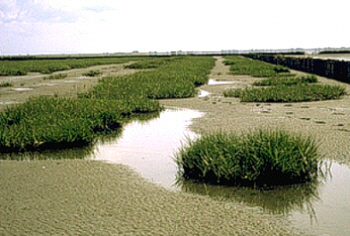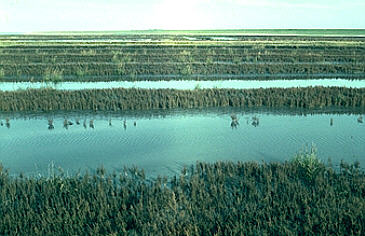We will start this chapter with several examples. Mathematical models can be found elsewhere:
1. The three species of gramineae Alopecurus pratensis, Arrhenatherum elatius, and Bromus erectus, for example depend just like other species on a certain amount of underground (telluric) water. In an experiment, they grew best with an average amount of underground water, but when all three species are cultivated together, Alopecurus pratensis and Bromus erectus cannot compete with the competition of Arrhenatherum elatius.
Growth of three graminaceous species in Rein- or mixed cultivation. A. experimental set-up. The area of the Beet is sloped so that the ground (subsoil) water table (level) is higher on its left than on its right side. B. growth optimum of the three species. C. Growth optima at mixed cultivation. Competition causes an underground (telluric) water-dependent distribution (H. WALTER, 1960, according to H. ELLENBERG, 1952).
In areas unsuited for Arrhenatherum because they are either too dry or too moist, the two otherwise less successful species thrive. Each has thus found its ecological niche.
The experiment represents the natural conditions very well. All three species are characteristic for meadows. Alopecurus pratensis meadows dominate the moist lowland of northern Germany, Arrhenatherum elatius meadows occur mainly in low mountain ranges, and Bromus erectus is characteristic for the dry grasslands of southern Germany.
2. The driving out of species after a new species has been introduced to a certain area is demonstrated very well by Spartina townsendii that grows on the North Sea coasts. This species that evolved during the second half of the 19th century on the English coast grows on the borders of the tidal zones in an area that is normally occupied by two other species. Salicornia europaea lives on the area that is regularly flooded by the tides, while Puccinellia maritima, a grass species, dominates the area that is higher due to sediments and is only sporadically flooded. The area that borders these two habitats is already relatively rich in species, Festuca rubra is its most characteristic species. The following diagram shows that Spartina townsendii grows both in the Salicornia and the Puccinellia habitats.

Zones of the dominant species of the silt deposition on the North Sea coast of Schleswig-Holstein (according to D. KÖNIG, 1948)
Spartina townsendii has driven out the original species in many places due to its faster growth and its higher production of biomass. Its spreading was originally welcomed, sometimes even supported as it was hoped that it would speed up the process of land reclamation. This proved to be a misconception, as Spartina townsendii is easily washed away during storm tides. The vegetation is thus torn open and further erosion occurs.


Spartina townsendii growing on the du flats of the North Sea coast of Schleswig-Holstein (Germany). The picture to the right shows the zone of Salicornia europaea.
3. Central Europe covers the plant zone of summer-green deciduous woods. The most common species and their preferred habitats are listed in the diagram below. Under natural condition, beeches ( Fagus sylvatica) live in Western Europe, firs ( Abies alba) in higher areas, while oak-hornbeam woods ( Quercus robur and Carpinus betulus) dominate in Eastern Europe. This is the result of to little spring and summer rain in Eastern Europe that are required by beeches for their optimal growth. Its dominance in Western Europe is due to fast growth and relatively low requirements in soil quality. Beech woods are rather poor in species, the zone of bushes and herbs is poorly developed as too little light reaches the ground. Typical are therefore species with vegetation periods that occur before the foliage of the beeches is fully developed, like Anemone nemorosa. Birches and pines, both species that require rather a lot of light have no chance in beech woods. Birches have, nevertheless, an advantage in biotops with a high ground water level, where beeches cannot thrive.

The distribution of the most common Central European tree species of sub-mountain ranges of temperate-suboceanic climates depends on the humidity and the pH value of the soils. The size of the letters does roughly mirror the part that the respective species plays in the given wood society (according to H. ELLENBERG, 1981).
Beech forests have in contrast to coniferous woods never a continuous moss cover. Mosses occur only on higher places like rocks or dead trees. The reason of their lacking is, that deciduous trees loose their foliage in autumn that becomes a dense cover leaving light no chance. This cover remains for month due to the rather slow decomposition and makes live impossible for mosses. The soil vegetation of oak woods differs completely from that of beech woods. As the foliage of oaks is not quite as dense as that of beeches, the light reaches the ground mosaic-like and causes a likewise mosaic distribution of plants in the shrub layer.
The advantage of the dominating species of all cases discussed so far is in their rapid growth. In other cases, dominance is based on the active driving out of competing species. Some blue-green algae and other algae secrete antibiotics or antibiotic-like substances into their medium in order to gain an advantage.
In the case of higher plants, a similar situation is known to occur with two Californian chaparral shrubs: Salvia leucophylla and Artemisia californica that secrete volatile toxic compounds (cineol and camphour) thus inhibiting the growth of herbs within one or two metres. They do thus gain an advantage over competing species, because their root system can develop undisturbed (water is rare in the chaparral!). Their wood, nevertheless, burns easily and fires are no uncommon events in this biotop, so that the area is subsequently free for herbs again that make better pioneers ( C. H. MULLER, 1966, 1968, University of California, Santa Barbara).
Hardly any species is able to live below a walnut tree (Juglans regia). The decomposing leaves of walnuts give off juglon, a substance that inhibits almost all plant growth as soon as it becomes dissolved in rain water. It develops by microbial decomposition from its non-toxic precursor hydrojuglon.
|